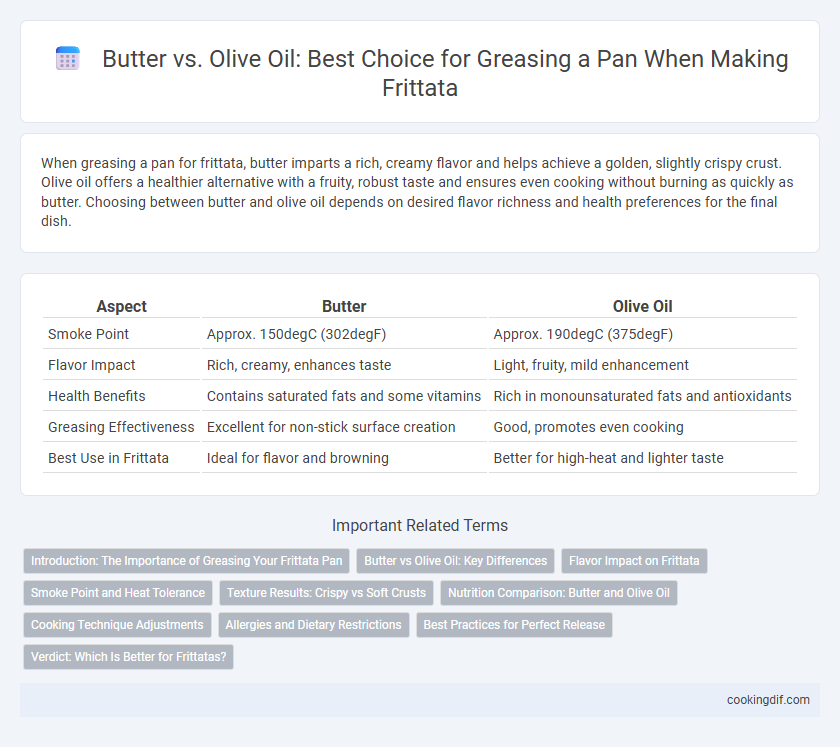When greasing a pan for frittata, butter imparts a rich, creamy flavor and helps achieve a golden, slightly crispy crust. Olive oil offers a healthier alternative with a fruity, robust taste and ensures even cooking without burning as quickly as butter. Choosing between butter and olive oil depends on desired flavor richness and health preferences for the final dish.
Table of Comparison
| Aspect | Butter | Olive Oil |
|---|---|---|
| Smoke Point | Approx. 150degC (302degF) | Approx. 190degC (375degF) |
| Flavor Impact | Rich, creamy, enhances taste | Light, fruity, mild enhancement |
| Health Benefits | Contains saturated fats and some vitamins | Rich in monounsaturated fats and antioxidants |
| Greasing Effectiveness | Excellent for non-stick surface creation | Good, promotes even cooking |
| Best Use in Frittata | Ideal for flavor and browning | Better for high-heat and lighter taste |
Introduction: The Importance of Greasing Your Frittata Pan
Greasing a frittata pan with butter or olive oil prevents sticking and ensures even cooking and browning. Butter adds a rich, creamy flavor and promotes a golden crust, while olive oil offers a healthier profile with a fruity, slightly peppery taste. Selecting the right fat enhances texture and flavor, crucial for a perfectly cooked frittata.
Butter vs Olive Oil: Key Differences
Butter provides a rich, creamy flavor and helps achieve a golden, slightly crispy crust on a frittata, while olive oil offers a lighter taste with heart-healthy monounsaturated fats and a higher smoke point. Butter contains milk solids that can brown quickly, adding a nutty aroma, whereas olive oil's antioxidants contribute to cardiovascular benefits and a smoother texture. Choosing between butter and olive oil depends on desired taste, nutritional value, and cooking temperature tolerance for optimal frittata results.
Flavor Impact on Frittata
Butter imparts a rich, creamy flavor that enhances the savory notes of a frittata, creating a slightly nutty and indulgent taste. Olive oil offers a more robust, fruity aroma that complements Mediterranean-style frittatas and adds a subtle earthiness. The choice between butter and olive oil significantly influences the flavor profile, making butter ideal for a traditional, decadent frittata and olive oil better suited for lighter, herb-forward versions.
Smoke Point and Heat Tolerance
Olive oil has a higher smoke point, typically around 375degF to 420degF, making it more suitable for greasing pans when cooking frittatas at moderate to high heat without burning. Butter's smoke point is lower, around 300degF, which can cause it to brown quickly and potentially impart a burnt flavor if the pan gets too hot. Choosing olive oil enhances heat tolerance and prevents smoke, while butter adds rich flavor but requires careful temperature control.
Texture Results: Crispy vs Soft Crusts
Using butter to grease the pan when making a frittata results in a rich, golden crust with a slightly crispy texture due to the milk solids caramelizing during cooking. Olive oil, on the other hand, creates a softer crust with subtle fruity notes, promoting a tender, less crunchy exterior. The choice between butter and olive oil directly affects the frittata's mouthfeel, with butter enhancing crispness and olive oil yielding a more delicate texture.
Nutrition Comparison: Butter and Olive Oil
Butter contains saturated fats and cholesterol, contributing to higher calorie content and potential heart health concerns, while olive oil is rich in monounsaturated fats and antioxidants that support cardiovascular health. Olive oil provides beneficial anti-inflammatory properties and vitamin E, which butter lacks, making it a healthier choice for greasing pans in terms of nutrition. The difference in smoke points also affects nutrient retention, with extra virgin olive oil having a moderate smoke point suitable for gentle cooking of frittatas.
Cooking Technique Adjustments
Using butter for greasing the pan in frittata preparation adds a rich flavor and creamy texture but requires careful temperature control to prevent burning due to its lower smoke point compared to olive oil. Olive oil offers a higher smoke point, allowing for more forgiving cooking temperatures and a slightly fruity taste, which can influence the overall flavor profile. Adjusting the heat levels and monitoring the pan carefully enhances the frittata's texture and prevents sticking, ensuring an evenly cooked and golden crust regardless of the fat used.
Allergies and Dietary Restrictions
Butter and olive oil are popular choices for greasing a pan when making frittatas, but dietary restrictions play a significant role in selection. Butter contains dairy, which can trigger allergies and lactose intolerance, making olive oil a better option for those avoiding animal products or following vegan diets. Olive oil also offers a heart-healthy fat profile, suitable for individuals with cholesterol concerns or those adhering to Mediterranean dietary practices.
Best Practices for Perfect Release
Using butter for greasing a pan when making frittata enhances flavor and promotes even browning due to its milk solids. Olive oil provides a non-stick surface with a higher smoke point, reducing the risk of burning and sticking during cooking. For best practices, combining butter and olive oil ensures both flavor and optimal release, preventing the frittata from sticking while achieving a golden crust.
Verdict: Which Is Better for Frittatas?
Olive oil offers a rich flavor and healthier fats, enhancing the frittata's taste and nutritional profile, while butter provides a creamy texture and a golden, crispy edge. For a traditional frittata, butter is preferred due to its ability to create a tender, browned crust that complements eggs. Choosing butter over olive oil results in a more authentic texture and flavor, making it the better greasing option for frittatas.
Butter vs Olive oil for greasing pan Infographic

 cookingdif.com
cookingdif.com